Abstract
Microcystin-LR (MCLR), a cyanotoxin widely present in freshwater, has been shown to have potent acute hepatotoxicity. However, the chronic toxicity of low-dose MCLR remains confusing by traditional measurements of toxicity. This has impeded understanding of the chronic liver damage of low-dose MCLR and corresponding safety risks of the human exposure guideline value. Here, iTRAQ-based proteomics and NMR-based metabonomics were used to decipher the molecular toxicological signatures of low doses of MCLR in mice exposed to this agent for 90 days. Low levels of MCLR, even under the reported no observed adverse effect level, significantly altered hepatic protein expression, especially of proteins associated with lipid metabolism, transport, immune and proteolysis. Coherently, MCLR induced marked perturbations in lipid metabolites in both liver and serum. Integrated analysis of proteomic, metabolic, histological and cytokine profiles revealed that MCLR significantly inhibited fatty acid β-oxidation and hepatic lipoprotein secretion and promoted hepatic inflammation, resulting in nonalcoholic steatohepatitis disease (NASH). These findings for the first time provide compelling evidence that chronic exposure to low-level MCLR can induce NASH. These results also indicate that current guidelines for MCs in drinking water may be inadequate and associated with risks to human health.







Similar content being viewed by others
References
Abu-Shanab A, Quigley EMM (2010) The role of the gut microbiota in nonalcoholic fatty liver disease. Nat Rev Gastroenterol Hepatol 7:691–701
Baffy G, Brunt EM, Caldwell SH (2012) Hepatocellular carcinoma in non-alcoholic fatty liver disease: an emerging menace. J Hepatol 56:1384–1391
Begriche K, Massart J, Robin M-A, Borgne-Sanchez A, Fromenty B (2011) Drug-induced toxicity on mitochondria and lipid metabolism: mechanistic diversity and deleterious consequences for the liver. J Hepatol 54:773–794
Buchman AL, Dubin MD, Moukarzel AA, Jenden DJ, Roch M, Rice KM, Gornbein J, Ament ME (1995) Choline deficiency: a cause of hepatic steatosis during parenteral nutrition that can be reversed with intravenous choline supplementation. Hepatology 22:1399–1403
Cave M, Falkner KC, Ray M, Joshi-Barve S, Brock G, Khan R, Bon Homme M, McClain CJ (2010) Toxicant-associated steatohepatitis in vinyl chloride workers. Hepatology 51:474–481. doi:10.1002/hep.23321
Chen J, Xie P, Li L, Xu J (2009) First identification of the hepatotoxic microcystins in the serum of a chronically exposed human population together with indication of hepatocellular damage. Toxicol Sci 108:81–89
Cheung O, Puri P, Eicken C, Contos MJ, Mirshahi F, Maher JW, Kellum JM, Min H, Luketic VA, Sanyal AJ (2008) Nonalcoholic steatohepatitis is associated with altered hepatic MicroRNA expression. Hepatology 48:1810–1820. doi:10.1002/hep.22569
Cohen JC, Horton JD, Hobbs HH (2011) Human fatty liver disease: old questions and new insights. Science 332:1519–1523. doi:10.1126/science.1204265
Dai M, Xie P, Liang G, Chen J, Lei H (2008) Simultaneous determination of microcystin-LR and its glutathione conjugate in fish tissues by liquid chromatography-tandem mass spectrometry. J Chromatogr B 862:43–50
Diehl AM, Li ZP, Lin HZ, Yang SQ (2005) Cytokines and the pathogenesis of non-alcoholic steatohepatitis. Gut 54:303–306. doi:10.1136/gut.2003.024935
Ding W-X, Nam Ong C (2003) Role of oxidative stress and mitochondrial changes in cyanobacteria-induced apoptosis and hepatotoxicity. FEMS Microbiol Lett 220:1–7. doi:10.1016/s0378-1097(03)00100-9
Dumas M-E, Barton RH, Toye A, Cloarec O, Blancher C, Rothwell A, Fearnside J, Tatoud R, Blanc V, Lindon JC, Mitchell SC, Holmes E, McCarthy MI, Scott J, Gauguier D, Nicholson JK (2006) Metabolic profiling reveals a contribution of gut microbiota to fatty liver phenotype in insulin-resistant mice. Proc Nat Acad Sci 103:12511–12516. doi:10.1073/pnas.0601056103
Falconer I, Humpage A (2005) Health risk assessment of cyanobacterial (blue–green algal) toxins in drinking water. Int J Env Res Public Health 2:43–50
Falconer IR, Beresford AM, Runnegar MT (1983) Evidence of liver damage by toxin from a bloom of the blue-green alga, Microcystis aeruginosa. Med J Aust 1:511–514
Fawell JK, James C, James H (1994) Toxins from blue-green algae: toxicological assessment of microcystin-LR and a method for its determination in water. Water research centre, Medmenham, UK, pp 1–46
Fawell JK, Mitchell RE, Everett DJ, Hill RE (1999) The toxicity of cyanobacterial toxins in the mouse: I Microcystin-LR. Hum Exp Toxicol 18:162–167. doi:10.1177/096032719901800305
Fullerton MD, Hakimuddin F, Bakovic M (2007) Developmental and metabolic effects of disruption of the mouse CTP: phosphoethanolamine cytidylyltransferase gene (Pcyt2). Mol Cell Biol 27:3327–3336. doi:10.1128/mcb.01527-06
Kuiper-Goodman T, Falconer IR, FItzgerald J (1999) Toxic cyanobacteria in water: a guide to their public health consequences, monitoring and management. E&FN Spon, London, pp 113–153
Lapaque N, Takeuchi O, Corrales F, Akira S, Moriyon I, Howard JC, Gorvel JP (2006) Differential inductions of TNF-α and IGTP, IIGP by structurally diverse classic and non-classic lipopolysaccharides. Cell Microbiol 8:401–413
Li Y, J-a Chen, Zhao Q, Pu C, Qiu Z, Zhang R, Shu W (2011) A cross-sectional investigation of chronic exposure to microcystin in relationship to childhood liver damage in the three gorges reservoir region, China. Environ Health Perspect 119:1483–1488. doi:10.1289/ehp.1002412
Li G, Cai F, Yan W, Li C, Wang J (2012) A proteomic analysis of MCLR-induced neurotoxicity: implications for Alzheimer’s disease. Toxicol Sci 127:485–495
Lim JS, Mietus-Snyder M, Valente A, Schwarz J-M, Lustig RH (2010) The role of fructose in the pathogenesis of NAFLD and the metabolic syndrome. Nat Rev Gastroenterol Hepatol 7:251–264
Lv H, Liu L, Zhang Y, Song T, Lu J, Chen X (2010) Ingenuity pathways analysis of urine metabonomics phenotypes toxicity of gentamicin in multiple organs. Mol BioSyst 6:2056–2067
Malatesta M, Caporaloni C, Rossi L, Battistelli S, Rocchi MBL, Tonucci F, Gazzanelli G (2002) Ultrastructural analysis of pancreatic acinar cells from mice fed on genetically modified soybean. J Anat 201:409–415. doi:10.1046/j.0021-8782.2002.00103.x
Mantovani A, Allavena P, Sica A, Balkwill F (2008) Cancer-related inflammation. Nature 454:436–444
Matsubara T, Tanaka N, Krausz Kristopher W, Manna Soumen K, Kang Dong W, Anderson Erik R, Luecke H, Patterson Andrew D, Shah Yatrik M, Gonzalez Frank J (2012) Metabolomics identifies an inflammatory cascade involved in dioxin- and diet-induced steatohepatitis. Cell Metabol 16:634–644. doi:10.1016/j.cmet.2012.10.006
Nishiwaki-Matsushima R, Ohta T, Nishiwaki S, Suganuma M, Kohyama K, Ishikawa T, Carmichael WW, Fujiki H (1992) Liver tumor promotion by the cyanobacterial cyclic peptide toxin microcystin-LR. J Cancer Res Clin Oncol 118:420–424
Paerl HW, Huisman J (2008) Climate—blooms like it hot. Science 320:57–58. doi:10.1126/science.1155398
Pessayre D, Mansouri A, Haouzi D, Fromenty B (1999) Hepatotoxicity due to mitochondrial dysfunction. Cell Biol Toxicol 15:367–373
Prows D, Murphy E, Schroeder F (1995) Intestinal and liver fatty acid binding proteins differentially affect fatty acid uptake and esterification in L-cells. Lipids 30:907–910. doi:10.1007/bf02537481
Ray SD, Jena N (2000) A hepatotoxic dose of acetaminophen modulates expression of BCL-2, BCL-XL, and BCL-XS during apoptotic and necrotic death of mouse liver cells in vivo. Arch Toxicol 73:594–606
Rocha MFG, Sidrim JJC, Soares AM, Jimenez GC, Guerrant RL, Ribeiro RA, Lima AAM (2000) Supernatants from macrophages stimulated with microcystin-LR induce electrogenic intestinal response in rabbit ileum. Pharmacol Toxicol 87:46–51. doi:10.1111/j.0901-9928.2000.870108.x
Seth RK, Kumar A, Das S, Kadiiska MB, Michelotti G, Diehl AM, Chatterjee S (2013) Environmental toxin linked nonalcoholic steatohepatitis and hepatic metabolic reprogramming in obese mice. Toxicol Sci 134:291–303. doi:10.1093/toxsci/kft104
Shi X, Wahlang B, Wei X, Yin X, Falkner KC, Prough RA, Kim SH, Mueller EG, McClain CJ, Cave M, Zhang X (2012) Metabolomic analysis of the effects of polychlorinated biphenyls in nonalcoholic fatty liver disease. J Proteome Res 11:3805–3815. doi:10.1021/pr300297z
SvirČEv Z, KrstiČ S, Miladinov-Mikov M, BaltiČ V, VidoviČ M (2009) Freshwater cyanobacterial blooms and primary liver cancer epidemiological studies in Serbia. J Environ Sci Health Part C 27:36–55. doi:10.1080/10590500802668016
Tan F, Jin Y, Liu W, Quan X, Chen J, Liang Z (2012) Global liver proteome analysis using iTRAQ labeling quantitative proteomic technology to reveal biomarkers in mice exposed to perfluorooctane sulfonate (PFOS). Environ Sci Technol 46:12170–12177. doi:10.1021/es3027715
Ueno Y, Nagata S, Tsutsumi T, Hasegawa A, Watanabe MF, Park H-D, Chen G-C, Chen G, Yu S-Z (1996) Detection of microcystins, a blue-green algal hepatotoxin, in drinking water sampled in Haimen and Fusui, endemic areas of primary liver cancer in China, by highly sensitive immunoassay. Carcinogenesis 17:1317–1321
Yoshida T, Makita Y, Nagata S, Tsutsumi T, Yoshida F, Sekijima M, S-i Tamura, Ueno Y (1997) Acute oral toxicity of microcystin-LR, a cyanobacterial hepatotoxin, in mice. Nat Toxins 5:91–95. doi:10.1002/1522-7189(1997)5:3<91:aid-nt1>3.0.co;2-h
Zhao Y, Xie P, Fan H (2011) Genomic profiling of microRNAs and proteomics reveals an early molecular alteration associated with tumorigenesis induced by MC-LR in mice. Environ Sci Technol 46:34–41
Zhao Y, Xie P, Fan H, Zhao S (2014) Impairment of the mitochondrial oxidative phosphorylation system and oxidative stress in liver of crucian carp (Carassius auratus L.) exposed to microcystins. Environ Toxicol 29:30–39
Acknowledgments
This work was funded by the National Natural Science Foundation of China (Grant No. 31322013) and State Key Laboratory of Freshwater Ecology and Biotechnology (Grant No. 2014FBZ02). The authors thank the Wuhan Institute of Physics and Mathematics, Chinese Academy of Science, for the use of their Bruker NMR spectrometers. The authors thank Hongbing Liu and Sizhe Chen for help with the NMR experiment and data processing. The authors also thank Shangchun Li, Wei Li, Xiaochun Guo, Huihui Fan, Dezhao Yu, Lijuan Xie and Sujuan Zhao for assistance with the animal experiments.
Author information
Authors and Affiliations
Corresponding author
Ethics declarations
Conflict of interest
The authors declare no competing financial interests.
Additional information
Jun He, Jun Chen and Guangyu Li have contributed equally to this work.
Electronic supplementary material
Below is the link to the electronic supplementary material.
Rights and permissions
About this article
Cite this article
He, J., Li, G., Chen, J. et al. Prolonged exposure to low-dose microcystin induces nonalcoholic steatohepatitis in mice: a systems toxicology study. Arch Toxicol 91, 465–480 (2017). https://doi.org/10.1007/s00204-016-1681-3
Received:
Accepted:
Published:
Issue Date:
DOI: https://doi.org/10.1007/s00204-016-1681-3




